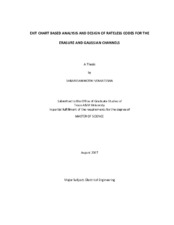| dc.description.abstract | Luby Transform Codes were the first class of universal erasure codes introduced
to fully realize the concept of scalable and fault‐tolerant distribution of data over
computer networks, also called Digital Fountain. Later Raptor codes, a generalization of
the LT codes were introduced to trade off complexity with performance. In this work,
we show that an even broader class of codes exists that are near optimal for the
erasure channel and that the Raptor codes form a special case. More precisely, Raptorlike
codes can be designed based on an iterative (joint) decoding schedule wherein
information is transferred between the LT decoder and an outer decoder in an iterative
manner. The design of these codes can be formulated as a LP problem using EXIT Charts
and density evolution. In our work, we show the existence of codes, other than the
Raptor codes, that perform as good as the existing ones.
We extend this framework of joint decoding of the component codes to the
additive white Gaussian noise channels and introduce the design of Rateless codes for
these channels. Under this setting, for asymptotic lengths, it is possible to design codes
that work for a class of channels defined by the signal‐to‐noise ratio. In our work, we
show that good profiles can be designed using density evolution and Gaussian
approximation. EXIT charts prove to be an intuitive tool and aid in formulating the code
design problem as a LP problem. EXIT charts are not exact because of the inherent
approximations. Therefore, we use density evolution to analyze the performance of these codes. In the Gaussian case, we show that for asymptotic lengths, a range of
designs of Rateless codes exists to choose from based on the required complexity and
the overhead.
Moreover, under this framework, we can design incrementally redundant
schemes for already existing outer codes to make the communication system more
robust to channel noise variations. | en |


